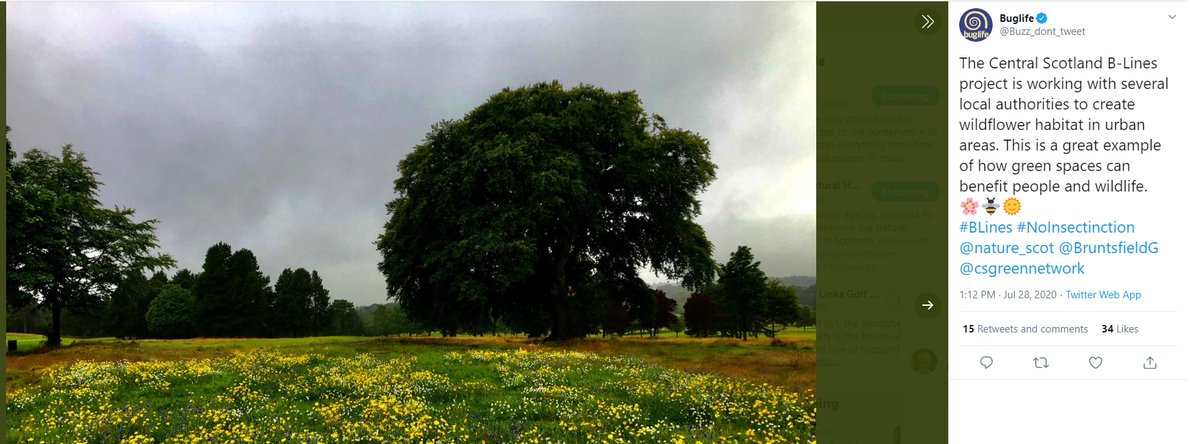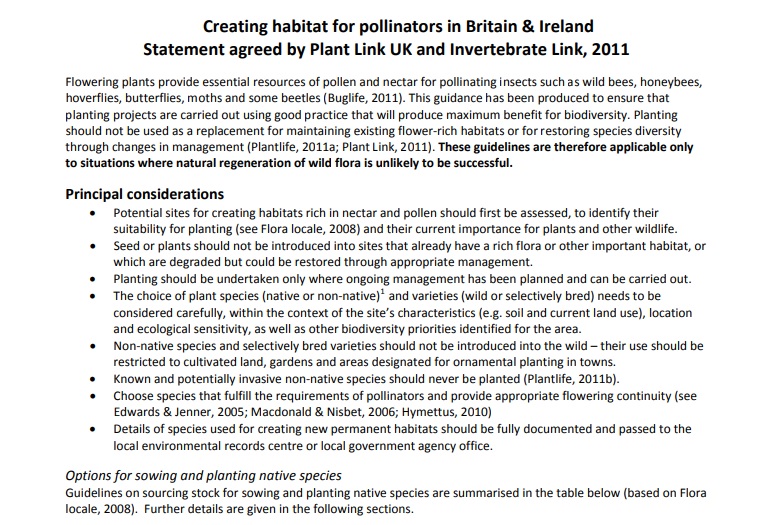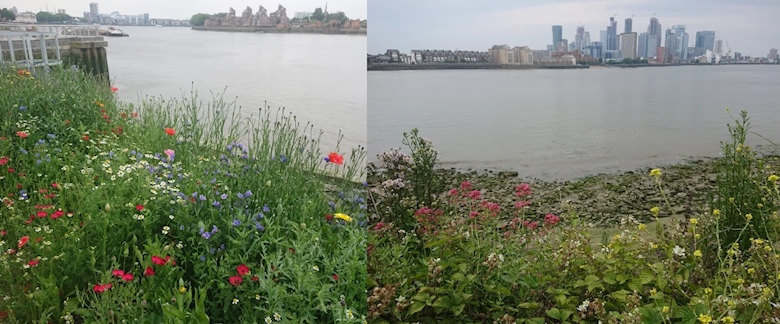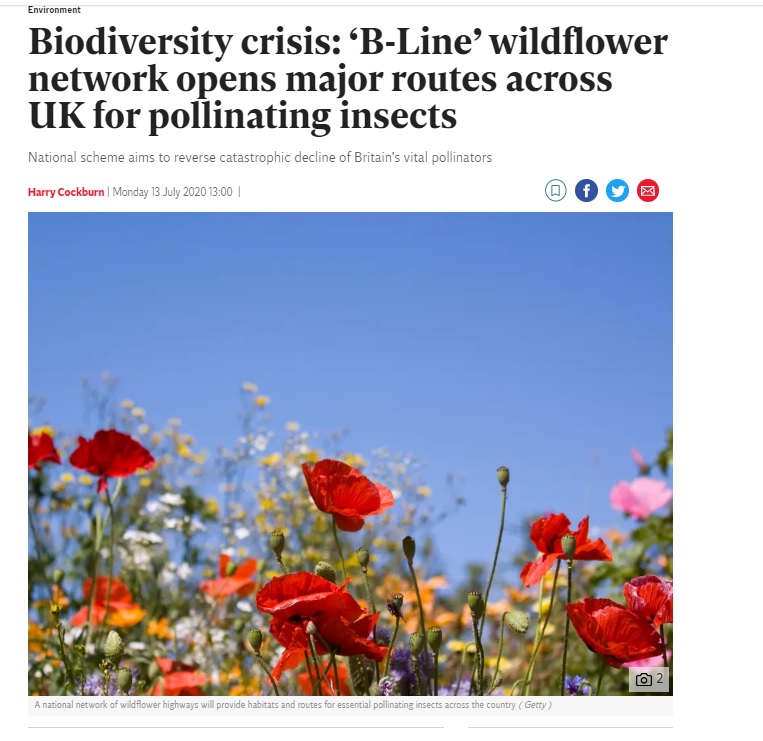1/n Apologies for ranting again about wildflowers. The charity Buglife undertakes great campaigns to raise awareness on insects. I was therefore disappointed to see that their "B-Lines" project is advertised using such pictures. Why? https://twitter.com/Buzz_dont_tweet/status/1288069889069142017">https://twitter.com/Buzz_dont...
2/n These are indeed British natives (or ancient introductions) such as poppies, cornflowers or corn marigold. No "non-natives" there. But I see some problems. Are they really the best plants for insects? Looking at the BRC Database of Insects & Host plants, it isn& #39;t evident:
3/n Next: cornfield species typically grow on bare soil along fields that are ploughed and disturbed. The photos in the tweet appear to show a park or an area of grassland - quite different from an agricultural field. You may say - is this a problem? Wildflowers are wildflowers.
4/n @BSBIscience& #39;s Kevin Walker wrote an excellent blog post here to address some of the concerns surrounding the craze for "wildflowers", which I encourage you to read: https://markavery.info/2020/06/12/guest-blog-wildflower-rich-road-verges-the-botanists-hen-harrier-by-kevin-walker/.">https://markavery.info/2020/06/1...
5/n Buglife& #39;s response was as follows: "in urban areas [...] there is more flexibility about what can be planted and creating a visual spectacle that the public enjoys and also benefits wildlife is vastly preferable to sterile mown grasslands.".
6/n Followed by a link to this document: https://cieem.net/wp-content/uploads/2019/07/Planting-For-Pollinators-Statement-2011.pdf.">https://cieem.net/wp-conten... This statement agreed by PLINK and Invertebrate LINK, 2 groups of conservation organisations is interesting on several points.
7/n It starts by mentioning pollination (somehow omitting the non-pollinating roles of insects). It goes on with a warning: "Planting should not be used as a replacement for maintaining existing [...] habitats or for restoring species diversity through changes in management"
8/n This is of course good advice - many of us botanists have been worried about natural habitats being replaced by seed mixes, with local species being lost. Any loss of plants can also result in a loss of local insects.
9/n Another consideration is that species must be chosen "within the context of the site’s characteristics (e.g. soil and current land use), location and ecological sensitivity". Are cornfield annuals really the most appropriate in this park or grassland context?
10/n I am surprised by the content of this document. For example, natural regeneration is not advised in urban brownfield areas, verges and parks - they should be enhanced with an "extensive palette of both native wild flowers [...] & non‐native but non‐invasive species"  https://abs.twimg.com/emoji/v2/... draggable="false" alt="🥺" title="Pleading face" aria-label="Emoji: Pleading face">
https://abs.twimg.com/emoji/v2/... draggable="false" alt="🥺" title="Pleading face" aria-label="Emoji: Pleading face">
11/n While it is true that many urban areas have been extensively modified, even the lawns around housing estates in the middle of London may retain some remnants of semi-natural habitats. Are we right to dismiss this diversity because it doesn& #39;t provide a "visual spectacle"?
12/n What I want to come to is that there seems to be a huge disconnect at the moment between botanists and entomologists in the UK. As someone who is a bit of both, it saddens me.  https://abs.twimg.com/emoji/v2/... draggable="false" alt="☹️" title="Stirnrunzelndes Gesicht" aria-label="Emoji: Stirnrunzelndes Gesicht"> Surely, insects are inseparable from plants, and we should be working together for a common goal
https://abs.twimg.com/emoji/v2/... draggable="false" alt="☹️" title="Stirnrunzelndes Gesicht" aria-label="Emoji: Stirnrunzelndes Gesicht"> Surely, insects are inseparable from plants, and we should be working together for a common goal
13/n I get the fact that B-lines make fantastic headlines, but by insisting on pretty flowers, nectar and pollen, are we really educating people to the problem of biodiversity loss? Many of our insects rely on "non-pretty" plants & habitats - grasses, nettles, dead wood, sand...

 Read on Twitter
Read on Twitter



![7/n It starts by mentioning pollination (somehow omitting the non-pollinating roles of insects). It goes on with a warning: "Planting should not be used as a replacement for maintaining existing [...] habitats or for restoring species diversity through changes in management" 7/n It starts by mentioning pollination (somehow omitting the non-pollinating roles of insects). It goes on with a warning: "Planting should not be used as a replacement for maintaining existing [...] habitats or for restoring species diversity through changes in management"](https://pbs.twimg.com/media/EeC8jNdWsAEbzAi.png)

![Pleading face 10/n I am surprised by the content of this document. For example, natural regeneration is not advised in urban brownfield areas, verges and parks - they should be enhanced with an "extensive palette of both native wild flowers [...] & non‐native but non‐invasive species" https://abs.twimg.com/emoji/v2/... draggable=](https://pbs.twimg.com/media/EeDA_MtX0AAUjT2.jpg) " title="10/n I am surprised by the content of this document. For example, natural regeneration is not advised in urban brownfield areas, verges and parks - they should be enhanced with an "extensive palette of both native wild flowers [...] & non‐native but non‐invasive species" https://abs.twimg.com/emoji/v2/... draggable="false" alt="🥺" title="Pleading face" aria-label="Emoji: Pleading face">">
" title="10/n I am surprised by the content of this document. For example, natural regeneration is not advised in urban brownfield areas, verges and parks - they should be enhanced with an "extensive palette of both native wild flowers [...] & non‐native but non‐invasive species" https://abs.twimg.com/emoji/v2/... draggable="false" alt="🥺" title="Pleading face" aria-label="Emoji: Pleading face">">
![Pleading face 10/n I am surprised by the content of this document. For example, natural regeneration is not advised in urban brownfield areas, verges and parks - they should be enhanced with an "extensive palette of both native wild flowers [...] & non‐native but non‐invasive species" https://abs.twimg.com/emoji/v2/... draggable=](https://pbs.twimg.com/media/EeDBT5-XYAcUZvx.jpg) " title="10/n I am surprised by the content of this document. For example, natural regeneration is not advised in urban brownfield areas, verges and parks - they should be enhanced with an "extensive palette of both native wild flowers [...] & non‐native but non‐invasive species" https://abs.twimg.com/emoji/v2/... draggable="false" alt="🥺" title="Pleading face" aria-label="Emoji: Pleading face">">
" title="10/n I am surprised by the content of this document. For example, natural regeneration is not advised in urban brownfield areas, verges and parks - they should be enhanced with an "extensive palette of both native wild flowers [...] & non‐native but non‐invasive species" https://abs.twimg.com/emoji/v2/... draggable="false" alt="🥺" title="Pleading face" aria-label="Emoji: Pleading face">">





